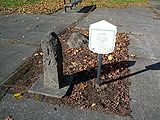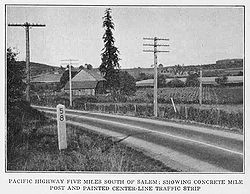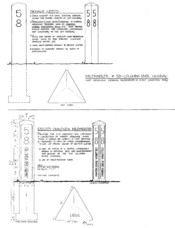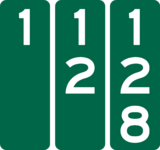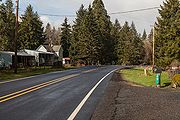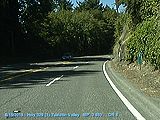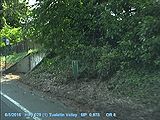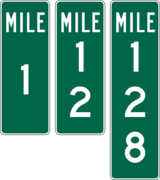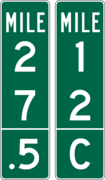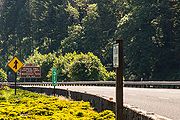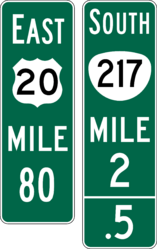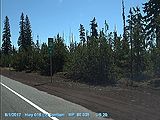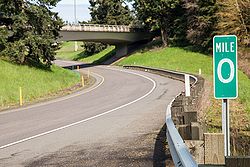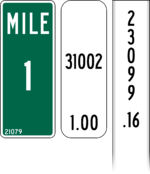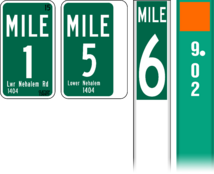Mileposts
Mileposts, also called mile markers, denote the distance between two termini on a highway or road. On state highways and county and local roads, the design and materials used for mile markers has changed drastically throughout the years.
Contents
- 1 Pre-State Highways
- 2 State Highways
- 3 County Roads
- 4 References
Pre-State Highways
Portland Baseline Mile Makers
Not much is known about mileposting of roads in Oregon prior to the creation of the OSHD, but the mile markers along Portland's Stark Street (formerly Baseline Road) are some of the oldest such mileposts in the state.
After John Preston, first Surveyor General for the Territory of Oregon, marked the intersection of the Willamette Baseline and the Willamette Meridian in June 1851, a road was soon built along the baseline east of Portland[1]. Appropriately called "Baseline Road", it was opened on November 24, 1854[1]. Some time after that, 15 stone mileposts were placed eastward along Baseline Road from the courthouse to the Sandy River, one stone per mile, using the Multnomah County Courthouse (between SW 4th/5th Avenues and Main/Salmon Streets) as the zero milepoint[1]. while no one is sure who placed them or when they were placed, it is believed to have been done in the 1870s by the United States Army operating out of the barracks on Front Street and Madison Avenue; they used a one-mile long rope tied to a wagon's axle to make the measurement[1].
Surprisingly, 9 of the original 15 markers survive today, which is even more incredible given the amount of widening Baseline Road/Stark Street has undergone the past 150 years; the downside is that none of the markers are likely in their original locations as a result[1]. Mile markers 1, 3, 8, 10, 12 and 15 are missing; all others have been preserved, rescued and/or reinstalled at some point in their history. The plaque in Ventura Park lists mile marker 11 as missing; however, it was since recovered in 1998 and re-set in 2000 with additional concrete[1].
It is believed that this process was repeated for roads heading in three other directions from Portland: Northerly along St. Helens Road/Lower Columbia River Highway (present-day US-30), southerly along a road near the West Side Pacific Highway, and westerly along Jefferson Street/Canyon Road or Burnside Street[1]. One mile marker, P7, can be found outside the Capitol Hill branch of the Multnomah Public Library on SW Captiol Highway along the supposed southern route. Otherwise, no other mile markers have been found along any other routing, despite rumors that three mile stones exist along the northerly alignment[1].
- P Mile Markers Around Portland
State Highways
Concrete Mileposts
Original Mileposts
Concrete mileposts were first platted in 1913, along the entirety of the Columbia River Highway from Astoria to The Dalles. The zero milepoint was in Portland, at the corner of SW Washington Street and Broadway; from there, mileage increased both easterly to The Dalles and westerly to Astoria[2]. They were triangular in design, about 3-4 feet tall, with the number carved into the two sides facing traffic.
In 1923, the OSHD audited its major highways, including the Columbia River Highway, to compile a list of features along the roads for recordkeeping and maintenance purposes; these lists became the 1924 "Mile Posting Data" log for each highway, a precursor to straightline charts that ODOT still uses today[3]. The Sixth Biennial Report of the Oregon State Highway Commission, published in 1924, features a photograph between pages 78 and 79 of one such milepost, MP 58, along the Pacific Highway a few miles south of Salem; it also describes their placement along five major highways, as well as their purpose:
Concrete mile posts indicating the distance from Broadway and Washington streets, Portland, have been set on the entire length of the Pacific and West Side Pacific Highways, also the Upper and Lower Columbia River Highways and Old Oregon Trail through to Ontario. These mile posts, having been accurately set, become an interesting and informative guide to tourists as well as affording valuable aid in designating maintenance operations, etc. Supplementing the mile posts, each bridge, culvert or other structure has been measured in and indicated on the department records with the proper decimal of the mile in which it is located. This permits the immediate location of all bridges and structures[4].
While the report only mentions the highways that would become US-99/99E/99W and US-30, OSHD policy at the time was to place "permanent concrete mileposts on all our main state highways"[5].
Due to realignments, widenings, theft and other reasons, very few original concrete mileposts have survived to the present day, with even fewer of them in their original locations. By 1987, only three original concrete mileposts existed along the entirety of the old Upper Columbia River Highway, with only one of them (milepost 58) still in good condition[6]. (Original milepost 14 is also present at the end of Sandy Blvd. in Wood Village where the old highway would have crossed over I-84; however, it's likely that it has been moved to that location.) For the Pacific Highway, original milepost 5 can be found on the 1900 block of SW Spring Garden Street, which was not a state highway; it likely came from the West Side Pacific Highway, where it would have been placed in the vicinity of Multnomah Village along present-day Capitol Highway. Original milepost 146 could be found in the Cottage Grove Museum by 2011, and original mileposts 285 and 286 were rediscovered along OR-99 around Savage Creek Road near Grants Pass in 2007[7].
Original concrete mileposts have also been discovered along former and abandoned alignments of The Dalles-California Highway in The Dalles-Dufur region. The designs of these mileposts are similar to the ones found on the Historic Columbia River Highway; however, the points on the triangular columns of these posts appear rounder and visible stamp outlines can be made out around the numbers. Mileposts 3, 9 and 12 are still standing, though milepost 3 is in poor condition. Milepost 18 was discovered broken on the side of US-197 on June 1, 2021, about 200 feet from where it originally stood. Milepost 19 is also said to have survived.
Restored Historic Columbia River Highway Mileposts
The need for milepost restoration along the old Columbia River Highway was identified as far back as 1981. In her National Park Service report Columbia River Highway: Options for Conservation and Reuse, Diane Ochi recommended adding back mileposts along the route as part of a unified signage overhaul along the route[8]. The newer mileposts would be of similar design to the original ones, but were more informational and intricate in design and placement:
- When installed, the posts would be oriented to point to the north.
- "Columbia River Highway" would appear underneath the number, rotated clockwise 90 degrees in order to fit on the post.
- Both the number and "Columbia River Highway" would be surrounded by a rounded-rectangular border, beveled at the same depth as the letters (¼-inch).
- The installation or designation year ("1981" in the etching) would be inscribed on top of the post.[8]
Ochi's grand vision for the new Columbia River Highway mileposts did not come to fruition, but the idea of milepost restoration along the highway lived on. By 1987, the state had allocated $10,000 to ODOT to cast and place concrete replacement mileposts along two state-owned portions of the old highway, the Crown Point Highway and the Mosier-The Dalles Highway[9]. These mileposts were similar in design and size to the ones originally placed along the highway, but the numbers were thicker and were painted white. Later projects, including the restorations of the Ruthton Point Viaduct and the Mosier Twin Tunnels, also received these mileposts. However, it is not known at this time if recently opened HCRH Trail segments have these stone mileposts on them.
Wooden Mileposts
At some point, the OSHD started utilizing wooden mileposts on its routes. They consisted of wooden logs buried in the ground, with the exposed part painted a light color (likely white) on top and the bottom/unexposed part painted a dark color (likely black). On the lighter part, large dark numerals were painted on the side. The top was pointed. The scope of the usage of these mileposts is unknown at this time, nor is it immediately known if numbers were painted on both sides (though it would seem likely).
MUTCD-Compliant Mileposts
1961 Standards
The 1961 edition of the MUTCD introduced mileposts into the standard, discussing their purpose, placement, zero-milepost orientation, and design[10]. Owing to their uniformity of standards, mileposts on Interstate freeways had a very specific color scheme and numeral size:
The Milepost panels are green, with 6-inch white reflectorized numerals[10].
The standard allowed more leeway for non-Interstate highways, allowing three different color schemes and two different numeral sizes:
It is recommended that these be simple panels, without border, having 4- to 6-inch numerals and no other legend. The numerals should be black on a white background or white on a green or black background, with suitable reflectorization[10].
Aside from the colors, numeral sizes, and the lack of border and other legends (which also applied to Interstates), no other guidance was given on other aspects such as shape, size, typeface, or numeral orientation.
When Oregon implemented mileposts according to their interpretation of the 1961 specification, they used green metallic panels 24 inches tall and 8 inches wide, with 6-inch numerals center-aligned descending from the top of the panel. The numerals were in reflectionized FHWA Gothic Series E and were not rotated. The panel was the same size regardless of how many digits were on it and the type of highway it was placed on. Almost none had borders on them.
The prevalence of these mileposts along state highways diminished in the 1980s and 1990s due to reconstruction projects and updated reflectionization standards; as a result, very few of these mileposts remain, occasionally on former state highways turned back over to county control:
- On US-101 in Depoe Bay, two could be found at MP 128 as of 2016. Both were in good condition.
- One can be found on OR-47 outside of Mist at MP 49 as of 2021. It was in excellent condition.
- One can be found on OR-99E just north of Hubbard at MP 28 as of 2019. It appeared to be in good condition.
- A few can be found on OR-210/Scholls Ferry Road between Kinton and Scholls at MP 2 and 3 as of 2021; MP 4 was present into the mid-2010s. All appeared to be in poor condition, but could also just have been extremely dirty.
- A pair could be found on OR-8 at MP 1 in Beaverton until the late-2010s. These ones were unique in that they had a border around them, a deviation from the 1961 spec. The westbound one was removed sometime around 2017 and the eastbound one around 2020. Both have since been replaced with modern mileposts. Prior to removal they were in good condition.
Others may still exist elsewhere in the state.
1971 Standards
AASHO revamped their standards in 1971, tightening up the variances in color, shape and size previously allowed. Also, borders and the word "MILE" were added in a complete reversal from the 1961 spec[11]. The previous requirements for Interstates were rolled into general requirements for freeways in this edition, and required larger mileposts:
Markers shall contain 10-inch white numerals on 12-inch wide vertical green panels with a white border. Panels shall be 24″, 36″, or 48″ in length for one, two, or three digits, respectively, and contain the word MILE[12].
Markers on non-freeways were just smaller versions of the freeway ones:
Milepost signs shall be vertical panels with 6-inch white numerals, a border and the word MILE in 4-inch letters on a green background and shall be reflectorized[11].
Three sizes were specified, based on how many numbers would be on the post:
- D10-1: For 1-digit numbers, 12″ × 24″ on freeways[12], 10″ × 18″ elsewhere[11]
- D10-2: For 2-digit numbers, 12″ × 36″ on freeways[12], 10″ × 27″ elsewhere[11]
- D10-3: For 3-digit numbers, 12″ × 48″ on freeways[12], 10″ × 36″ elsewhere[11]
Aside from the size of the numbers and the MILE legend, no typeface suggestions were given. However, the example image in the MUTCD itself appears to use FHWA Gothic Series D for the numerals and Series B for the MILE legend[11].
Oregon mostly adopted the milepost standard as defined in the MUTCD. However, the state opted to use the D10-2 2-digit marker for 1-digit mileposts, with the number vertically centered between MILE and the bottom of the post. This practice was utilized on both freeway and non-freeway routes through the mid-2000s, when ODOT started using the D10-1 marker more frequently for single-digit mileposts. Recently completed transportation projects, like the Sunrise Expressway and the Rogue Valley Expressway, use D10-1 single-digit panels.
Two of Oregon's first major implementations of the 1971 standard mileposts occurred around early 1972, when the entirety of mileposts on Interstates 5 and 80N were replaced. Interstate 5's mileposts were originally from north to south, but needed to be switched to running south-to-north, per 1961 AASHO standards; Interstate 80N's mileposts were being changed to incorporate increased mileage from the selection of the Mount Hood Freeway corridor. State Highway Engineer R. L. "Rod" Porter estimated that the cost of revising both highways' milepost systems and installing the new mileposts would cost $25,000 total — $11,500 for I-5 and $13,500 for I-80N — and would need to be done with state forces instead of by several contractors[13].
Technically, just about any milepost on a state highway in Oregon that only includes a border, a MILE legend and large numbers on whole miles is a 1971 specification MUTCD milepost. That said, Oregon does have quite a few subtle variations based primarily on number size and typeface, usually FHWA Series C or D. In addition, later MUTCD specs included variations that Oregon has implemented from time to time.
2003 Standards
The 1971 MUTCD descriptions for mileposts remained more or less the same for more than 30 years, even after a name change to the more generic "reference posts" in 2000. These standards also allowed for fractional mileposts of some kind, using either delimiters or reference posts at consistent intervals. However, they weren't considered part of the milepost system until 2003, when AASHTO introduced them as "intermediate reference location markers". These mileposts have the same design as the 1971 spec, but with an extra section below the mile number that contains the fractional portion, with decimal (such as ".3")[14]. The decimal portion is always displayed, even on whole numbers where a ".0" is placed in that section.
The 2003 MUTCD defined sizes for freeway and expressway placement, but not for other highways and roads. Their dimensions are estimated based on the original D10 mileposts of comparable size.
- D10-1a: For 1-digit numbers – 12″ × 36″ on freeways, 10″ × 27″ elsewhere[14]
- D10-2a: For 2-digit numbers – 12″ × 48″ on freeways, 10″ × 36″ elsewhere[14]
- D10-3a: For 3-digit numbers – 12″ × 60″ on freeways, 10″ × 45″ elsewhere[14]
Oregon's first implementation of this standard, however, was not for fractional mileposts. Instead, the mileposts were used to differentiate between sections of US-395 where mileposts reset to zero due to Oregon's dual highway/route system. This resetting confused travelers at best and hindered emergency services at worst, so ODOT decided to add letters in the spot on the post where the fraction would normally reside[15]. ODOT initially added them on two sections in late 2008 or early 2009 — the section of US-395 from Pendleton to Mt. Vernon received "B" while the section from John Day to near Burns received "C"[16]. Letter suffixes "D" and "E" were added to two portions from near Riley to the California border by 2013[15]; these ones omit the line between the numbers and letter, making them effectively like an original D10 milepost with 4 alphanumerics on them.
The letter suffix system was expanded to OR-207 by early 2018, using "A", "B" and "C" along three different sections[17].
As far as actual fractional mileposts are concerned, their first usage in Oregon was on US-26 between Sandy and the junction of OR-35, installed at half-mile intervals in the summer of 2011 as part of and ODOT pilot project[18]. Since then, Oregon has expanded their usage on other highways to improve response times. Freeway-size D10-2a markers has been installed at half-mile intervals in the median of I-84 through the Columbia River Gorge, and smaller D10-1a mileposts were installed on the Multnomah County section of then-future OR-127 in the summer of 2019[19]. Oregon also has placed a D10-2a marker at MP 68.9 along US-26 near Clear Creek in the Mount Hood National Forest in an attempt to avoid the "Mile 69 Problem".
2009 Standards
The 2009 standard added another milepost type, "enhanced reference location signs", to further aid motorists and emergency responders[20]. These mileposts contained a cardinal direction, route shield and whole mile number. Two different varieties were defined, one for whole numbers (D10-4) and one for fractional miles (D10-5) which included an extra section below the mileage for the decimal part. Both varieties only came in one size, regardless of mile number or highway type:
- D10-4: For whole miles only – green or blue, 18″ × 54″[21]
- D10-5: For whole and fractional miles – green or blue, 18″ × 60″[21]
Legends need to be at least 6 inches tall and shields need to be at least 12 inches tall[20]. For typefaces on both, the examples in the MUTCD showed the cardinal direction and whole mile number in FHWA Series B, and with "MILE" and the fractional mile (if present) in Series C.
Oregon has not used these type of mileposts very often, but they are present in the state. D10-5 markers were installed at half-mile intervals along OR-217 in the summer of 2011 as part of the same pilot project that installed 2003-spec D10-2a markers along US-26[18]. These markers largely matched those in the MUTCD, but used FHWA Series C for the whole mile number instead of Series B. As of 2021 they do not appear to have been implemented along any other freeway within Oregon.
In addition, D10-4 mileposts can be found in a rare non-freeway instance intermittently along US-20 through the Cascades. Installed around 2016 or 2017, these ones more or less follow the MUTCD example typeface-wise. Some examples can be found at MP 75, MP 80 and MP 83.
Miscellany
- Oregon posted zero mileposts in two locations in the late 2010s: At the northern terminus of OR-551 and at the junction of I-5 and OR-99E Business in Keizer. These are possibly the first zero mileposts along a state-maintained highway in Oregon.
- Rarely, some mileposts will have a "Z" above the number, such as on a section of US-101 near Wheeler. This is due to a highway realignment or cancellation and is used to denote duplicate mileposts along a highway, and is similar to "B"-mileage in Washington or "R"-mileage in California. For additional information on Oregon's milepoint system, see Mileposting in Oregon.
County Roads
Clackamas County
Three different kinds of mileposts can be found on Clackamas County roads:
- Green MUTCD D10-2 mileposts for 1- and 2-digit numbers, marked at whole miles
- White metallic rounded rectangles, marked at culverts in hundredths of a mile
- White delineator wickets embedded in the ground, also marked at culverts in hundredths of a mile
Each of these mileposts contains the mileage and a 5-digit county road number. This number can sometimes span two different roads if they comprise a longer route, such as Stafford and Wilsonville Roads.
The green mileposts used to be more prevalent in the 1990s but have been disappearing as they're damaged or otherwise removed. The white markers are much more prominent, but can be more hidden and sometimes don't face traffic.
At jurisdictional boundaries, the white markers can also sometimes be found with "BCM" and "ECM", for "begin county maintenance" and "end county maintenance" respectively, depending on the direction of travel. Metal rectangle versions of these posts can also contain the county road number.
Zero mileposts can be found among all three types, though the green ones are much rarer.
Clatsop County
Mileposts
Prior to the mid 2010s, mileposts on Clatsop County roads appeared only on green wickets placed in the vicinity of a culvert. These wickets only show the mileage in hundredths of a mile, without identifying any sort of road name or number. The typeface used is a thinner stroke version of Helvetica Inserat Roman.
In early 2015, some roads were provided with mileposts in three new distinct styles, leaving the green wickets intact:
- A standard D10-1 or D10-2 milepost, mounted on a post in the center, with some additions:
- The 2-digit year of manufacture or installation is in black in the upper right
- The road name and number are in white on the bottom towards the left
- "Clatsop County" is in black on the lower right
- A different D10-1 (and possibly D10-2) milepost, mounted on a post to the side, with the road name and number on the bottom as the only additions; the number on these ones are FHWA Series B, vs. Series C or D on standard D10 markers.
- A white wicket with a green sticker stating "MILE" and the mile number; all letters and numbers are condensed FHWA Series C
Other variations may also exist, but have yet to be discovered or documented.
Bridge Inventory Markers
Columbia County
Coos County
Douglas County
Hood River County
Linn County
Marion County
Marion County doesn't appear to put mileposts along its county roads.
Multnomah County
Tillamook County
Umatilla County
Wasco County
Wasco County doesn't appear to put mileposts along its county roads.
Washington County
Yamhill County
Yamhill County doesn't appear to put mileposts along its county roads.
References
- ↑ 1.0 1.1 1.2 1.3 1.4 1.5 1.6 1.7 Felker, Jeff. "The Willamette Stone and the Baseline Rd Markers," The Stark Street Mile Markers blog, 23 May 2008, last accessed 8 May 2021
- ↑ Taylor, Michael C. Road of Difficulties. Bear Creek Press, Wallowa (Oregon), 2008, p. 27
- ↑ Unknown author. Internal ODOT memo, 2005
- ↑ Sixth Biennial Report of the Oregon State Highway Commission, 1924, p. 16
- ↑ Klein, Roy letter to C. H. Purcell, 6 August 1924
- ↑ Oregon Department of Transportation. A Study of the Historic Columbia River Highway, November 1987, p. 64
- ↑ Medford Mail-Tribune. "Since You Asked: Old Mileposts Still on Highway 99," 7 October 2007
- ↑ 8.0 8.1 Ochi, Diane. Columbia River Highway: Options for Conservation and Reuse, National Park Service, 1981, p. 89
- ↑ Gronowski, Nancy H. & Jeanette Kloos. A Study of the Historic Columbia River Highway, Oregon Department of Transportation, November 1987, p. 119
- ↑ 10.0 10.1 10.2 AASHO. Manual for Uniform Traffic Control Devices, 1961 Edition, June 1961, p. 110
- ↑ 11.0 11.1 11.2 11.3 11.4 11.5 AASHO. Manual for Uniform Traffic Control Devices, 1971 Edition, 13 November 1970, pp. 110-111
- ↑ 12.0 12.1 12.2 12.3 AASHO. Manual for Uniform Traffic Control Devices, 1971 Edition, 13 November 1970, pp. 164 & 166
- ↑ Porter, R. L. letter to R. E. Simpson, 9 December 1971, p. 1
- ↑ 14.0 14.1 14.2 14.3 AASHTO. Manual for Uniform Traffic Control Devices, 2003 Edition, November 2003, p. 2D-27
- ↑ 15.0 15.1 Oregon Department of Transportation. "The A, B, C's of U.S. 395 Mile Markers in Oregon", 15 August 2013
- ↑ The East Oregonian. "ODOT Assigns Letters to Parts of Highway 395," 28 November 2008, last updated 13 December 2008, last accessed 23 May 2021
- ↑ Oregon Department of Transportation. "The A, B, C's of Mile Markers in Oregon", 5 January 2018
- ↑ 18.0 18.1 Hart, Jim. "New Mile Markers Posted Along Highway 26," The Sandy Post, 9 August 2011
- ↑ Multnomah County. "Cornelius Pass Road Safety Improvements," last updated 18 December 2020, https://multco.us/roads/webform/cornelius-pass-road-safety-improvements, last accessed 8 February 2021
- ↑ 20.0 20.1 AASHTO. Manual for Uniform Traffic Control Devices, 2009 Edition with Revisions 1 and 2 Incorporated, May 2012, p. 296
- ↑ 21.0 21.1 AASHTO. Manual for Uniform Traffic Control Devices, 2009 Edition with Revisions 1 and 2 Incorporated, May 2012, p. 292

